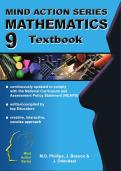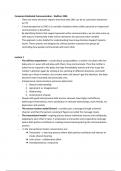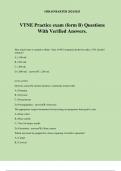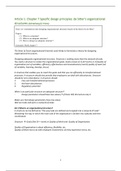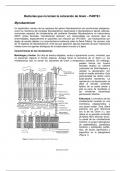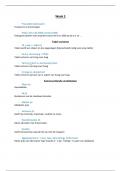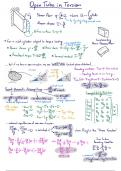Department of Chemical Engineering
Process Instrumentation and Control III
Lecture: TP Makhathini
Email:
031 907 7141
INTRODUCTION TO PROCESS INSTRUMENTATION
Human progress from a primitive state to our present complex, technological world has been
marked by learning new and improved methods to control the environment. Simply stated, the
term control means methods to force parameters in the environment to have specific values. This
can be as simple as making the temperature in a room stay at or as complex as manufacturing an
integrated circuit or guiding a spacecraft to Jupiter. In general, all the elements necessary to
accomplish the control objective are described by the term control system. The purpose of this
module is to examine the elements and methods of control system operation used in industry to
control industrial processes (hence the term process control). This learning unit will present an
overall view of process-control technology and its elements, including important definitions.
1. CONTROL SYSTEMS
The basic strategy by which a control system operates is logical and natural. In fact, the same
strategy is employed in living organisms to maintain temperature, fluid flow rate, and a host of
other biological functions. This is natural process control. The technology of artificial control was
first developed using a human as an integral part of the control action. When we learned how to
use machines, electronics, and computers to replace the human function, the term automatic
control came into use.
1.1 Process-Control Principles
In process control, the basic objective is to regulate the value of some quantity. To regulate
means to maintain that quantity at some desired value regardless of external influences. The
desired value is called the reference value or setpoint. In this section, a specific system will be
used to introduce terms and concepts employed to describe process control.
The Process Figure 1 shows the process to be used for this discussion. Liquid is flowing into a
tank at some rate, Qout, and out of the tank at some rate, Qout. The liquid in the tank has some
Johnson, C.D (2014) Process Control Instrumentation Technology, 8th ed. Rev Date: 29 October 2020
, Department of Chemical Engineering
Process Instrumentation and Control III
Lecture: TP Makhathini
Email:
031 907 7141
height or level, h. It is known that the output flow rate varies as the square root of the height, Qout
= K√ℎ, so the higher the level, the faster the liquid flows out. If the output flow rate is not
exactly equal to the input flow rate, the level will drop, if Qout < Qin, or rise, if Qout < Qin.
This process has a property called self-regulation. This means that for some input flow rate, the
liquid height will rise until it reaches a height for which the output flow rate matches the input
flow rate. A self-regulating system does not provide regulation of a variable to any particular
reference value. In this example, the liquid level will adopt some value for which input, and output
flow rates are the same, and there it will stay. But if the input flow rate changed, then the level
would change also, so it is not regulated to a reference value.
EXAMPLE 1 The tank in Figure 1 has a relationship between flow and level given by Qout =
K√ℎ, where h is in feet and K = 1.156 (gal/min)/ft1/2. Suppose the input flow rate is 2 gal/min. At
what value of h will the level stabilize from self-regulation?
Solution
The level will stabilize from self-regulation when Qout = Qin. Thus, we solve for h,
2
2
𝑄𝑜𝑢𝑡 2 𝑔𝑎𝑙/𝑚𝑖𝑛
ℎ=( ) =( ) = 3𝑓𝑡
𝐾 𝑔𝑎𝑙
1.156 (min)/𝑓𝑡 1/2
Suppose we want to maintain the level at some particular value, H, in Figure 1, regardless of the
input flow rate. Then something more than self-regulation is needed.
Human-Aided Control Figure 2 shows a modification of the tank system to allow artificial
regulation of the level by a human. To regulate the level so that it maintains the value H, it will be
necessary to employ a sensor to measure the level. This has been provided via a “sight tube,” S, as
shown in Figure 2. The actual liquid level or height is called the controlled variable. In addition, a
valve has been added so that the output flow rate can be changed by the human. The output flow
rate is called the manipulated variable or controlling variable.
Johnson, C.D (2014) Process Control Instrumentation Technology, 8th ed. Rev Date: 29 October 2020
, Department of Chemical Engineering
Process Instrumentation and Control III
Lecture: TP Makhathini
Email:
031 907 7141
Now the height can be regulated apart from the input flow rate using the following strategy: The
human measures the height in the sight tube and compares the value to the setpoint. If the measured
value is larger, the human opens the valve a little to let the flow out increase, and thus the level
lowers toward the setpoint. If the measured value is smaller than the setpoint, the human closes
the valve a little to decrease the flow out and allow the level to rise toward the setpoint. By a
succession of incremental opening and closing of the valve, the human can bring
Johnson, C.D (2014) Process Control Instrumentation Technology, 8th ed. Rev Date: 29 October 2020
, Department of Chemical Engineering
Process Instrumentation and Control III
Lecture: TP Makhathini
Email:
031 907 7141
the level to the setpoint value, H, and maintain it there by continuous monitoring of the sight
tube and adjustment of the valve. The height is regulated.
Automatic Control To provide automatic control, the system is modified as shown in Figure 3 so
that machines, electronics, or computers replace the operations of the human. An instrument called
a sensor is added that is able to measure the value of the level and convert it into a proportional
signal, s. This signal is provided as input to a machine, electronic circuit, or computer called the
controller. The controller performs the function of the human in evaluating the measurement and
providing an output signal, u, to change the valve setting via an actuator connected to the valve by
a mechanical linkage. When automatic control is applied to systems like the one in Figure 3, which
are designed to regulate the value of some variable to a setpoint, it is called process control.
2. PROCESS-CONTROL BLOCK DIAGRAM
To provide a practical, working description of process control, it is useful to describe the elements
and operations involved in more generic terms. Such a description should be independent of a
particular application (such as the example presented in the previous section) and thus be
applicable to all control situations. A model may be constructed using blocks to represent each
distinctive element. The characteristics of control operation then may be developed from a
consideration of the properties and interfacing of these elements. Numerous models have been
employed in the history of process-control description; we will use one that seems most
appropriate for a description of modern and developing technology of process control.
2.1 Identification of Elements
The elements of a process-control system are defined in terms of separate functional parts of the
system. The following paragraphs define the basic elements of a process-control system and
relate them to the example presented above.
Process
In the previous example, the flow of liquid in and out of the tank, the tank itself, and the liquid
all constitute a process to be placed under control with respect to the fluid level. In general, a
process can consist of a complex assembly of phenomena that relate to some manufacturing
sequence. Many variables may be involved in such a process, and it may be desirable to control
all these variables at the same time. There are single variable processes, in which only one
variable is to be controlled, as well as multivariable processes, in which many variables, perhaps
interrelated, may require regulation. The process is often also called the plant.
Measurement
Clearly, to effect control of a variable in a process, we must have information about the variable
itself. Such information is found by measuring the variable. In general, a measurement refers to
the conversion of the variable into some corresponding analog of the variable, such as a pneumatic
Johnson, C.D (2014) Process Control Instrumentation Technology, 8th ed. Rev Date: 29 October 2020
Process Instrumentation and Control III
Lecture: TP Makhathini
Email:
031 907 7141
INTRODUCTION TO PROCESS INSTRUMENTATION
Human progress from a primitive state to our present complex, technological world has been
marked by learning new and improved methods to control the environment. Simply stated, the
term control means methods to force parameters in the environment to have specific values. This
can be as simple as making the temperature in a room stay at or as complex as manufacturing an
integrated circuit or guiding a spacecraft to Jupiter. In general, all the elements necessary to
accomplish the control objective are described by the term control system. The purpose of this
module is to examine the elements and methods of control system operation used in industry to
control industrial processes (hence the term process control). This learning unit will present an
overall view of process-control technology and its elements, including important definitions.
1. CONTROL SYSTEMS
The basic strategy by which a control system operates is logical and natural. In fact, the same
strategy is employed in living organisms to maintain temperature, fluid flow rate, and a host of
other biological functions. This is natural process control. The technology of artificial control was
first developed using a human as an integral part of the control action. When we learned how to
use machines, electronics, and computers to replace the human function, the term automatic
control came into use.
1.1 Process-Control Principles
In process control, the basic objective is to regulate the value of some quantity. To regulate
means to maintain that quantity at some desired value regardless of external influences. The
desired value is called the reference value or setpoint. In this section, a specific system will be
used to introduce terms and concepts employed to describe process control.
The Process Figure 1 shows the process to be used for this discussion. Liquid is flowing into a
tank at some rate, Qout, and out of the tank at some rate, Qout. The liquid in the tank has some
Johnson, C.D (2014) Process Control Instrumentation Technology, 8th ed. Rev Date: 29 October 2020
, Department of Chemical Engineering
Process Instrumentation and Control III
Lecture: TP Makhathini
Email:
031 907 7141
height or level, h. It is known that the output flow rate varies as the square root of the height, Qout
= K√ℎ, so the higher the level, the faster the liquid flows out. If the output flow rate is not
exactly equal to the input flow rate, the level will drop, if Qout < Qin, or rise, if Qout < Qin.
This process has a property called self-regulation. This means that for some input flow rate, the
liquid height will rise until it reaches a height for which the output flow rate matches the input
flow rate. A self-regulating system does not provide regulation of a variable to any particular
reference value. In this example, the liquid level will adopt some value for which input, and output
flow rates are the same, and there it will stay. But if the input flow rate changed, then the level
would change also, so it is not regulated to a reference value.
EXAMPLE 1 The tank in Figure 1 has a relationship between flow and level given by Qout =
K√ℎ, where h is in feet and K = 1.156 (gal/min)/ft1/2. Suppose the input flow rate is 2 gal/min. At
what value of h will the level stabilize from self-regulation?
Solution
The level will stabilize from self-regulation when Qout = Qin. Thus, we solve for h,
2
2
𝑄𝑜𝑢𝑡 2 𝑔𝑎𝑙/𝑚𝑖𝑛
ℎ=( ) =( ) = 3𝑓𝑡
𝐾 𝑔𝑎𝑙
1.156 (min)/𝑓𝑡 1/2
Suppose we want to maintain the level at some particular value, H, in Figure 1, regardless of the
input flow rate. Then something more than self-regulation is needed.
Human-Aided Control Figure 2 shows a modification of the tank system to allow artificial
regulation of the level by a human. To regulate the level so that it maintains the value H, it will be
necessary to employ a sensor to measure the level. This has been provided via a “sight tube,” S, as
shown in Figure 2. The actual liquid level or height is called the controlled variable. In addition, a
valve has been added so that the output flow rate can be changed by the human. The output flow
rate is called the manipulated variable or controlling variable.
Johnson, C.D (2014) Process Control Instrumentation Technology, 8th ed. Rev Date: 29 October 2020
, Department of Chemical Engineering
Process Instrumentation and Control III
Lecture: TP Makhathini
Email:
031 907 7141
Now the height can be regulated apart from the input flow rate using the following strategy: The
human measures the height in the sight tube and compares the value to the setpoint. If the measured
value is larger, the human opens the valve a little to let the flow out increase, and thus the level
lowers toward the setpoint. If the measured value is smaller than the setpoint, the human closes
the valve a little to decrease the flow out and allow the level to rise toward the setpoint. By a
succession of incremental opening and closing of the valve, the human can bring
Johnson, C.D (2014) Process Control Instrumentation Technology, 8th ed. Rev Date: 29 October 2020
, Department of Chemical Engineering
Process Instrumentation and Control III
Lecture: TP Makhathini
Email:
031 907 7141
the level to the setpoint value, H, and maintain it there by continuous monitoring of the sight
tube and adjustment of the valve. The height is regulated.
Automatic Control To provide automatic control, the system is modified as shown in Figure 3 so
that machines, electronics, or computers replace the operations of the human. An instrument called
a sensor is added that is able to measure the value of the level and convert it into a proportional
signal, s. This signal is provided as input to a machine, electronic circuit, or computer called the
controller. The controller performs the function of the human in evaluating the measurement and
providing an output signal, u, to change the valve setting via an actuator connected to the valve by
a mechanical linkage. When automatic control is applied to systems like the one in Figure 3, which
are designed to regulate the value of some variable to a setpoint, it is called process control.
2. PROCESS-CONTROL BLOCK DIAGRAM
To provide a practical, working description of process control, it is useful to describe the elements
and operations involved in more generic terms. Such a description should be independent of a
particular application (such as the example presented in the previous section) and thus be
applicable to all control situations. A model may be constructed using blocks to represent each
distinctive element. The characteristics of control operation then may be developed from a
consideration of the properties and interfacing of these elements. Numerous models have been
employed in the history of process-control description; we will use one that seems most
appropriate for a description of modern and developing technology of process control.
2.1 Identification of Elements
The elements of a process-control system are defined in terms of separate functional parts of the
system. The following paragraphs define the basic elements of a process-control system and
relate them to the example presented above.
Process
In the previous example, the flow of liquid in and out of the tank, the tank itself, and the liquid
all constitute a process to be placed under control with respect to the fluid level. In general, a
process can consist of a complex assembly of phenomena that relate to some manufacturing
sequence. Many variables may be involved in such a process, and it may be desirable to control
all these variables at the same time. There are single variable processes, in which only one
variable is to be controlled, as well as multivariable processes, in which many variables, perhaps
interrelated, may require regulation. The process is often also called the plant.
Measurement
Clearly, to effect control of a variable in a process, we must have information about the variable
itself. Such information is found by measuring the variable. In general, a measurement refers to
the conversion of the variable into some corresponding analog of the variable, such as a pneumatic
Johnson, C.D (2014) Process Control Instrumentation Technology, 8th ed. Rev Date: 29 October 2020

